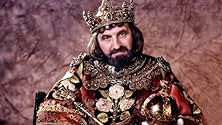King John does whatever it takes to keep himself on the throne of England, making enemies of the pope, France, and his nephew along the way.King John does whatever it takes to keep himself on the throne of England, making enemies of the pope, France, and his nephew along the way.King John does whatever it takes to keep himself on the throne of England, making enemies of the pope, France, and his nephew along the way.
- Director
- Writer
- All cast & crew
- Production, box office & more at IMDbPro
Storyline
Did you know
- TriviaFor this production, director David Giles chose to go with a semi-stylised setting which he referred to as both "emblematic" and "heraldic."
- ConnectionsFeatured in Shakespeare's Women & Claire Bloom (1999)
Featured review
The chronology places "King John" between "Midsummer Night's Dream" and "Merchant of Venice," but this play is not on that level. The quality of the writing is remarkably inconsistent compared with more familiar texts. However the BBC production gives the play a fighting chance, and it's worth exploring.
This Shakespeare series often roped in familiar faces from light television for leading roles, to broaden the viewing audience. Sometimes the stars would open the play with recognizable tics to reassure their public, and then abandon them as they gained confidence during the course of the play.
One example is John Cleese in "Taming of the Shrew," and Leonard Rossiter does it here too. After a tentative beginning, Rossiter acquits himself well by his final scene. George Costigan as Philip the Bastard also starts out fairly cluttered, and gains a welcome simplicity by the end. John Thaw is quite good as Hubert de Burgh, and Inspector Morse addicts will have trouble recognizing him.
The women disappear from the plot fairly early, but here they get the acting honors. Mary Morris is magnetic as old Queen Elinor, and Claire Bloom wrestles valiantly with the unactable part of Lady Constance.
The stylized physical production owes more than a little to the Olivier "Henry V," with a medieval manuscript illustration feel to the scenes in France. Altogether a worthy excursion off the beaten path.
This Shakespeare series often roped in familiar faces from light television for leading roles, to broaden the viewing audience. Sometimes the stars would open the play with recognizable tics to reassure their public, and then abandon them as they gained confidence during the course of the play.
One example is John Cleese in "Taming of the Shrew," and Leonard Rossiter does it here too. After a tentative beginning, Rossiter acquits himself well by his final scene. George Costigan as Philip the Bastard also starts out fairly cluttered, and gains a welcome simplicity by the end. John Thaw is quite good as Hubert de Burgh, and Inspector Morse addicts will have trouble recognizing him.
The women disappear from the plot fairly early, but here they get the acting honors. Mary Morris is magnetic as old Queen Elinor, and Claire Bloom wrestles valiantly with the unactable part of Lady Constance.
The stylized physical production owes more than a little to the Olivier "Henry V," with a medieval manuscript illustration feel to the scenes in France. Altogether a worthy excursion off the beaten path.
- tonstant viewer
- Feb 3, 2007
- Permalink
Details
- Release date
- Countries of origin
- Language
- Also known as
- The Complete Dramatic Works of William Shakespeare: The Life and Death of King John
- Production companies
- See more company credits at IMDbPro
Contribute to this page
Suggest an edit or add missing content

Top Gap
What was the official certification given to The Life and Death of King John (1984) in Japan?
Answer


























